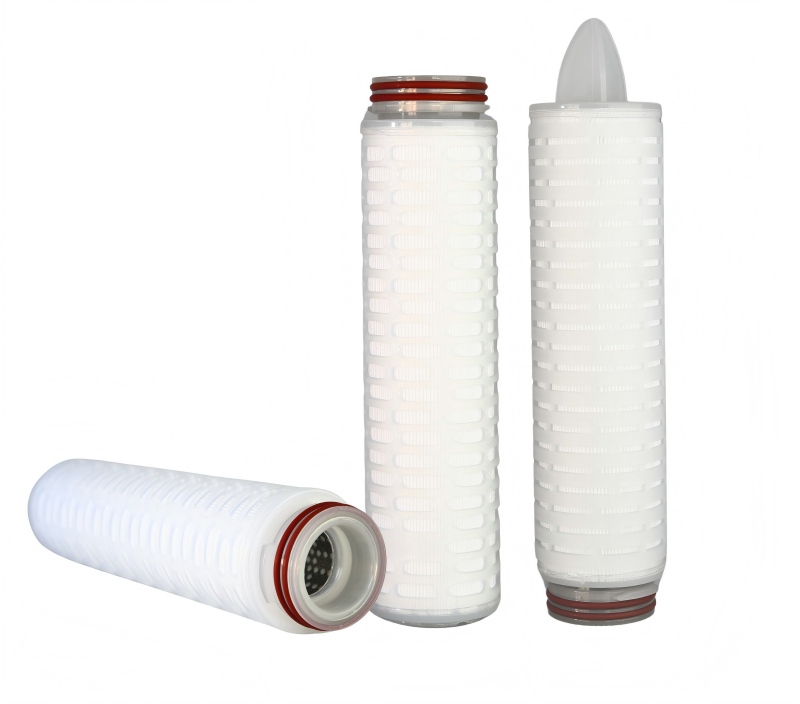Analysis of the Application of Double-Layer PES Sterilising Pleated Filter Cartridges in the Pharmaceutical Industry
2025-11-10
Within the pharmaceutical sector, the sterility of medicinal solutions constitutes a core indicator for ensuring drug safety. Dual-layer PES (polyethersulfone) sterilising pleated filter cartridges, leveraging their ‘dual retention + stable sterilisation’ characteristics, have become pivotal filtration components in the production of sterile pharmaceuticals such as injectables and biological agents. They effectively address the insufficient safety redundancy encountered with single-layer cartridges in high-risk scenarios.
Structurally, the dual-layer PES sterilising pleated filter represents a functional upgrade over traditional single-layer filters, employing a ‘gradient pore size + symmetrical composite’ dual-layer configuration.
The first layer serves as the coarse filtration retention layer, employing a PES membrane with a pore size of 1.0–5.0μm. Its primary function is to pre-treat large particulate impurities in the pharmaceutical solution (such as residual raw materials and colloidal aggregates), preventing subsequent clogging of the fine filtration layer and associated flux reduction. This also reduces the contaminant load on the fine filtration layer, thereby extending the overall service life of the filter cartridge.
The second layer is the sterilising fine filtration layer, employing a high-precision PES membrane with a 0.22μm pore size (the pharmaceutical industry standard for sterile filtration). This layer constitutes the sterilisation core, employing a dual mechanism of ‘sieving effect + adsorption’ to achieve a 99.999% retention rate for microorganisms including bacteria and mycoplasma. This fully complies with the filtration requirements for sterile pharmaceuticals stipulated in the Good Manufacturing Practice (GMP) for Pharmaceutical Products.
Furthermore, the two membrane layers are tightly bonded via a hot-melt lamination process, eliminating gaps and the risk of lateral leakage. The entire filter cartridge features a fully polypropylene frame (end caps, central tube), with all parts in contact with the pharmaceutical solution being biocompatible materials. This prevents secondary contamination of the solution from leachables or shedding particles.
Application Value
In pharmaceutical manufacturing scenarios, the application value of dual-layer PES sterile pleated filter cartridges is primarily demonstrated in three core processes.
Firstly, terminal filtration of pharmaceutical solutions: prior to filling injectables, the dual-layer cartridge performs final sterilising filtration. For instance, in antibiotic injection production, the coarse filtration layer first traps raw material microcrystals within the solution, while the fine filtration layer thoroughly removes any potential contaminants, ensuring post-filling sterility compliance and preventing product wastage due to microbial contamination.
Secondly, sterile gas filtration. During bioreactor aeration, the dual-layer cartridge filters incoming sterile air: the coarse layer blocks airborne dust particles while the fine layer traps bacterial spores. This prevents external microbial ingress into the reactor, safeguarding the sterile stability of the cell culture environment. This application is particularly critical in the production of biological agents such as monoclonal antibodies.
Thirdly, cleaning and sterilisation validation: owing to the high-temperature resistance of PES material (capable of withstanding 121°C saturated steam sterilisation), the dual-layer cartridge can undergo sterilisation-in-place (SIP) alongside the equipment. Post-sterilisation, rapid performance validation is achieved through integrity testing (e.g., bubble point testing), eliminating the need for frequent disassembly and replacement. This approach reduces equipment downtime while mitigating contamination risks during handling, meeting the pharmaceutical industry's dual demands for efficient production and stringent safety controls.
Furthermore, the dual-layer PES sterile-in-place pleated filter cartridge offers exceptional adaptability. Its dual-membrane pore size configuration can be tailored to different pharmaceutical liquid characteristics (such as viscosity and corrosiveness). For instance, high-viscosity Chinese herbal injection solutions may utilise a ‘3.0μm coarse filtration + 0.22μm fine filtration’ combination to balance throughput and filtration efficiency.
For pharmaceutical solutions containing organic solvents, the PES material's outstanding chemical stability (resistance to acids, alkalis, and organic solvents) eliminates concerns about cartridge swelling or performance degradation, further expanding its application scope within the pharmaceutical sector.





